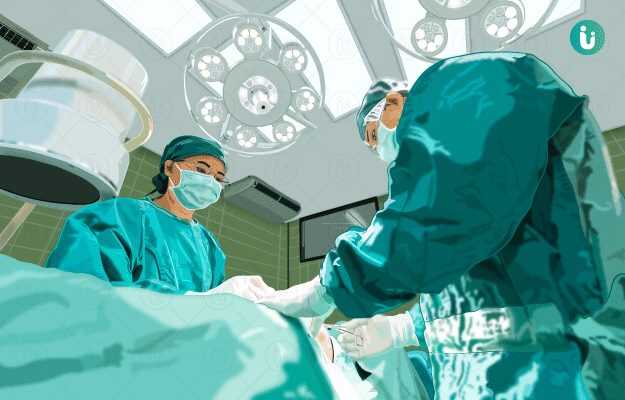Summary
Rhinectomy is the surgical removal of the nose, in entirety or part. It is, therefore, classified into two types, partial and total rhinectomy. The nasal skin is vulnerable to changes from exposure to sunlight, which predisposes it to cancers. Additionally, the nasal lining is quite delicate and cannot stop the spread of invasive (metastasised) cancers. Nasal cancers spread rapidly to the eyes, lips and other surrounding tissues. Owing to the sensitive cosmetic nature of rhinectomy, it is less commonly carried out. It is particularly indicated for aggressive and invasive cancers that have spread widely to the nasal regions. Rhinectomy often needs to be followed by reconstructive procedures.
- What is rhinectomy?
- Why is rhinectomy recommended?
- Who can and cannot get rhinectomy?
- What preparations are needed before a rhinectomy?
- How is rhinectomy done?
- How to care for yourself after rhinectomy?
- What are the possible complications/risks of rhinectomy?
- When to follow up with your doctor after a rhinectomy?
What is rhinectomy?
Rhinectomy is the surgical removal of the nose in whole or part. In this procedure, the soft tissue of the nose is removed along with most of the nasal framework.
Nose holds a significant place in the aesthetic appeal of a person while being equally important functionally. However, the placement of the nose exposes it to the sunlight and makes it prone to nasal skin cancer.
The external nose is made up of bone and cartilage and divided on the inside by the anterior nasal septum (a wall-like structure) into nostrils. The nasal cavity is the space behind the nose into which the nostrils open. It is present above the top of the mouth and connects with the mouth at the back of the throat. The air breathed in through the nostrils is warmed and moistened in the nasal cavity. The bacteria in the air that we breathe are also removed in this space.
Nasal cancers often begin inside the nasal cavity or in the small air-filled spaces within the bones close to the nasal cavity called paranasal sinuses. Cancers originating in tissues at the lower end of the nasal septum and in the nasal cavity tissues towards the entrance of the nose tend to be invasive and aggressive as the thin tissue lining of the cavity does not offer any resistance to the spread of the tumour.
Since the nasal cavity is close to the ears, mouth and eyes, cancer of the nasal cavity can easily spread to the surrounding bones, cartilages, cheeks and lips through the periosteum (the thin membrane that covers the bones). Most nasal cavity cancers are squamous cell carcinoma and adenocarcinoma (cancer of the mucus-producing glands; mucus is a fluid that moistens the air we breathe and filters out the bacteria).
Rhinectomy involves the resection (removal) of the cancerous growth while preserving substantial tumour margins (edge or border along which no cancer cells are present), followed by the reconstruction of the nose to restore its appearance and function.
Rhinectomy is of two types:
- Partial rhinectomy - a limited portion of the nasal structure is removed.
- Total rhinectomy - the skin, the structure of the external nose and soft tissue.
Rhinectomy is done only for aggressive (fast-spreading), extensive or recurrent cancers. It has severe consequences to the aesthetic appeal of a person; therefore, it is not the first line of treatment. It is only performed after radiation therapy or surgery has failed.
Why is rhinectomy recommended?
Rhinectomy is suggested in people with the following conditions:
- Individuals with a wider spread of the skin cancer to outer regions of the nose and nasal cavity:
- Commonly occurring types of cancer are basal cell carcinoma and squamous cell carcinoma (SCC) (a type of cancer that develops in the cells that form the skin or tissues)
- A rarer type is melanoma (cancer that develops in the cells called melanocytes, which produce the pigment melanin that gives skin its colour)
- Adnexal tumours (cancer of the hair follicles and sweat- and oil-producing glands in the skin)
- Merkel cell carcinoma (cancer of the Merkel cells in the skin)
- A large spread of the malignant cancers, such as SCCs and adenocarcinomas of the nasal cavity to the columella (the tip of the nose beyond the septum separating the two nostrils), vestibule (formed by the anterior nasal septum, columella and lower lateral cartilages), septum and sides of the nasal cavity.
- Cancer that is persistent and returns (recurrent) with more than one location (multifocal) after radiation therapy or surgery.
- As a way to provide some relief (or palliative treatment) to better the quality of life, despite the cancer having spread to farther sites (metastases).
People with nasal or paranasal cancers often present with the following symptoms:
Persistent nose problems:
- Mucus coming out of the nose
- Mucus flowing into the back of the nose and throat
- Blocked and stuffy feeling on one side of the nose that does not go away
- Nosebleeds
- Reduced sense of smell
Eye problems:
- Double vision
- Bulging of one eye
- Partial or complete loss of sight
- Pain around the eye
- Watery discharge or tears from the eye falling down the cheek
Other symptoms:
- Numb feeling or pain that persists in different areas of the face, especially the upper cheek
- Difficulty in opening the mouth
- Lymph nodes in the neck that have a swelling or appear enlarged. Read more: Swollen lymph nodes symptoms
- Pressure or pain in any of the ears
- Lump or growth on the face, nose or roof of the mouth that does not go away
- Loose teeth
Who can and cannot get rhinectomy?
Rhinectomy is contraindicated in the following cases:
- Further widespread metastases. It is not recommended in cases of extreme spread of the cancer, although it may be performed to provide palliative care.
- Comorbid conditions (other co-existing serious health conditions) with a risk to tolerate anaesthesia
- The individual does not prefer surgery
What preparations are needed before a rhinectomy?
The preparations for the surgery include the following:
- A biopsy, computed tomography and magnetic resonance imaging of the area requiring surgery will be performed to confirm the diagnosis.
- Blood tests will be done to evaluate an individual’s general health condition and identify the blood type in case a transfusion might be required.
- Breathing tests and chest x-ray will be required to assess the lung function.
- ECG and exercise – ECG will be done to evaluate the function of the heart.
- Your blood pressure, pulse, temperature, general health and weight will be checked.
- You should inform the doctor about your past and present medical illnesses and surgical history.
- Inform your doctor of any allergies, including to medications or anaesthesia
- Your facial, nasal, oral cavity and neck regions will be examined in detail to plan the surgery.
- You will need to provide consent prior to the surgery.
- In individuals who will undergo nose reconstruction, tissue from other parts of the body will be used to restore and recreate the nose and its structures. Some tests will be carried out to check the health of these tissues and ensure that they have a good blood supply.
- You will receive adequate counselling regarding the cosmetic outcome of the surgery. You must ask and clarify all doubts with the surgeon before the surgery.
- Individuals with metastases to the neck lymph nodes will be counselled on the need for dissection of the neck during the surgery, its outcome and alternatives, if any, prior to the surgery.
- The anaesthetist will discuss the options of anaesthetic for the surgery.
- A dietician will advise you on the foods and nutritional supplements to be started prior to the surgery.
- You may be shown some breathing and leg exercises that need to be followed after surgery to help prevent chest infections and blood clots in the legs, respectively.
- You will have to take medications that prevent blood clots from forming in the legs. These may be administered as small injections under the skin of the legs prior to the surgery. Additionally, you may have to wear compression stockings.
- A speech therapist will advise you on the types of food to be consumed that will make swallowing easier after the surgery.
- You should stop smoking and tobacco use a few weeks prior to the surgery, especially if reconstructive surgery is also to be carried out.
- All blood thinner (anticoagulant and antiplatelet) medications, supplements and herbal products should be stopped after consulting the doctor.
- On the evening prior to the surgery and the morning of the surgery, you may be asked to consume a carbohydrate-rich drink that supplies energy and makes recovery faster. In case you cannot consume it, fluids will be intravenously injected via a drip.
How is rhinectomy done?
Before proceeding to begin the surgery, the following should be taken care of:
- You must have a shower and wear loose and comfortable clothing.
- You must not use any deodorant, moisturiser, creams, lotions, powders or perfumes.
- You should wear spectacles and not contact lenses during surgery.
- You will have to remove all jewellery and body piercings.
- Your doctor will give you broad-spectrum antibiotics prior to the surgery (to reduce the risk of infections).
The surgery is performed as follows:
- You will be given general anaesthesia using a tube inserted into your trachea or the windpipe through your mouth (orotracheal intubation).
- You will be made to lie down flat on your back such that your head is higher than your feet and slightly turned towards the physician.
- The surgeon will lay down small, absorbent gauze (pledgets) inside your nasal cavity.
- He/she will cut open your nasal skin at the outer edges of one nostril, over the bridge (or dorsum) and to the inferior skin incision of the other nostril. This type of dissection separates the cartilages from the bony structures.
- The surgeon will then draw back your nasal skin to allow access to the septum and visualise the extent of the spread of cancer.
- Next, he/she will cut the base of the columella, exposing the cartilaginous structures of the septum.
- The surgeon will cut the bony septum and other nasal bones (osteotomy) using surgical instruments and complete the resection or removal of the tumour with the osteotomies (surgical cutting of bone to allow change its alignment).
- The surgeon will then use endoscopes to explore your nasal cavity to detect any remaining tumours.
- Tumour margins will be evaluated by the frozen section technique, and fresh margins will be removed if needed. Clean surgical margins are vital to successful surgery.
- Finally, the surgeon will suture the skin and mucosal edges together and place a sterile compressed sponge or gauze soaked in an antibiotic ointment around the cavity to reduce and prevent further post-surgical bleeding. This sponge will be removed after three days.
- The cavity will be left open to heal as the edges of the tissues cannot be brought together to suture. This procedure is known as secondary healing.
- The open cavity will be closed and restored after the reconstruction using prosthesis(implants) or reconstruction flaps.
In a total rhinectomy, the skin of the nose, soft tissue and framework of the external nose are removed.
The post-surgical care after rhinectomy is as follows:
- You will either be in the recovery room or the intensive care unit when you wake up after surgery, depending on the extent of the surgery.
- You may feel drowsy and disoriented when you first wake up, which is due to the effect of anaesthesia and painkillers. As the anaesthesia wears off, you will gradually feel better.
- Your oxygen levels, pulse, temperature, and blood pressure will be monitored.
- Drips containing fluids, painkillers and antibiotics will be given until you resume eating and drinking.
- You may also have a feeding tube that provides with liquid food until you can start eating. Once the wound heals, you can begin eating light and soft foods.
- A catheter (the tube that drains urine) will be attached from your bladder.
- The wound will have some drainage tubes attached to draw away the collected fluid.
- A thin tube may also be in place to drain the fluid that is collected in the stomach.
- Use of saline water to clean the nasal cavities along with cool mist humidification at least twice daily reduces the crust formation and washes away any debris that may build up.
- Your haemoglobin and haematocrit levels will be evaluated.
- While sleeping, the doctor may suggest you keeping the head of your bed elevated, and ice will be applied to reduce the swelling in the region.
- Nose packs are often taken out in 24-48 hours after surgery.
- The wound will have stitches that will be removed after 10 days or longer until they heal.
- A dressing may also be placed over the wound that stays in place for a few days. In cases of skin grafts (skin from a part of the body has been used to reconstruct the nose), there will be two wounds.
- Analgesics (painkillers) will be administered to reduce the pain. However, non-steroidal drugs will be initially avoided.
- Counselling and psychological support will be given for aesthetic and functional concerns.
- You must be mobile early on after the surgery. A physiotherapist will visit every day to help with the exercises that speed up recovery.
- Recovery is slow and differently paced for different people. Your doctor will provide the best advice on when to resume work. If you have a desk job, you can resume earlier than in jobs involving heavy lifting.
How to care for yourself after rhinectomy?
Your doctor will suggest the following to help you to care for yourself while at home:
- You should follow a special diet as advised by your dietician.
- It is normal to feel tired for many weeks to months after the surgery. It is important to be mobile, sit for lesser time, walk around the house more each day and walk outdoors.
- You should take your pain medications as directed by the doctor.
- You should drink 10 glasses of water daily to help with bowel movements and keep constipation away.
- Your stitches may be cut before discharge from hospital. If not, they may be removed at a follow-up visit. Alternately, if you have had radiation therapy to the neck before surgery, it may take two to three weeks for the stitches to be removed.
- You can have a sponge bath for the first 48 hours after surgery or as directed by your doctor. It is important to keep the tubes and drains dry and not go near the incision as well as not go very close to your incision.
- You will face changes in your sense of smell and taste. These conditions will improve with time.
- For the first six weeks after surgery:
- Cough and sneeze with the mouth open
- Do not put anything in your nose and never lower the head below the shoulders
- Do not perform strenuous activities or sports
- Do not lift anything heavy
- No flight journeys
Shorter surgical duration is one of the benefits of this surgery.
When to See the Doctor?
You must visit the doctor immediately if you see the following:
- Increased redness or discomfort or both around your incisions
- Fluid accumulates or drains from your incisions
- The incision region feels warm to the touch
- Breathlessness
- Increased swelling around the incisions
- Changes in appetite and sleep pattern
- Feelings of sadness and helplessness that last for long or other signs of depression
What are the possible complications/risks of rhinectomy?
The possible complications or risks of rhinectomy are:
- Bleeding from the facial, ophthalmic (eye) and maxillary arteries.
- Cerebrospinal fluid leak: It occurs as a result of excessive handling of the ethmoid bone, which is the bone that separates the nasal cavity from the brain. If the leak is not attended to during surgery, it can lead to meningitis (inflammation of the meninges-the coverings of the brain), encephalitis (inflammation of the brain) and brain abscess (formation of pus due to inflammation).
- Return (recurrence) of cancer.
- Injury to the hard palate of the mouth.
When to follow up with your doctor after a rhinectomy?
Follow-up visits and regular health check-ups are very crucial in the prevention and management of head and neck cancers as the risk of a relapse is higher.
The first follow-up visit will be at six weeks, and slowly the frequency will reduce. After about two years, you will have check-up visits every three to six months. After three years, you will have follow-up visits every six months until five years.
For squamous cell cancers, you may need to see a specialist once a year for 10 years.
Disclaimer: The above information is provided purely from an educational point of view and is in no way a substitute for medical advice by a qualified doctor.
Surgery Cost In Your City
References
- Myers EN, Snyderman CH. Operative Otolaryngology: Head and Neck Surgery. 3rd ed. Elsevier. 2018.
- Bailey BJ, Calhoun KH. Head & Neck Surgery—Otolaryngology. 4th ed. Lippincott Williams & Wilkins. 2006.
- Cancer Research UK [Internet]. London. UK; Nasal and paranasal sinus cancer
- Memorial Sloan Kettering Cancer Center. Gerstner Sloan Kettering Graduate School of Biomedical Sciences [internet]. U.S. About Your Nasal Cavity and Paranasal Sinus Surgery
- Chipp E, Prinsloo D, Rayatt S. Rhinectomy for the management of nasal malignancies. J Laryngol Otol. 2011;125(10):1033‐1037. PMID: 21810291.
- National Health Service [internet]. UK; Nasal and sinus cancer















